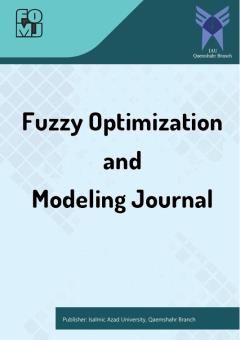Ridge Regression With Intuitionistic Fuzzy Input and Output: A Parametric Approach
Subject Areas : Fuzzy Optimization and Modeling JournalZahra Behdani 1 , Majid Darehmiraki 2
1 -
2 -
Keywords: Intuitionistic Fuzzy Number, Regression Model, Ridge regression, Distance,
Abstract :
Ridge regression is a model that is frequently used and has numerous effective applications, particularly in the management of correlated factors in a multiple regression model. Additionally, multicollinearity poses a significant risk in fuzzy regression models when it comes to predictions. In order to solve this problem, we bring together the fuzzy regression model with the ridge regression technique. Regarding the evaluation of the coefficients of the ridge fuzzy regression model, the algorithm that we have suggested makes use of the parametric estimation approach. In this article, we examine the ridge regression in the intuitionistic fuzzy environment. We assume that the input and output data are intuitionistic fuzzy numbers. Since in the regression analysis we need to calculate the distance between the variables, we define a new fuzzy parametric distance. Also, the goodness of fit of the model with the indicators of the mean square of the prediction error has been investigated in simulation examples and real data.
1. Akram, M., Sarwar, M., & Borzooei, R. A. (2018). A novel decision-making approach based on hypergraphs in intuitionistic fuzzy environment. Journal of Intelligent & Fuzzy Systems, 35(2), 1905-1922.
2. Atanassov, K. T. (2012). On intuitionistic fuzzy sets theory (Vol. 283). Springer.
3. Choi, S. H., Jung, H. Y., & Kim, H. (2019). Ridge fuzzy regression model. International Journal of Fuzzy Systems, 21(7), 2077-2090.
4. Diamond. P, (1987). Least squares fitting of several fuzzy variables. In 2nd Int. Fuzzy Syst. Assoc. IFSA World Congress, 329-331.
5. Durso, P., & Chachi, J. (2022). OWA fuzzy regression. International Journal of Aapproximate Reasoning, 142, 430-450.
6. Ejegwa, P. A., & Adamu, I. M. (2019). Distances between intuitionistic fuzzy sets of second type with application to diagnostic medicine. Notes on Intuitionistic Fuzzy Sets, 25(3), 53-70.
7. Flores-Sosa, M., Aviles-Ochoa, E., Merigo , J. M., & Kacprzyk, J. (2022). The OWA operator in multiple linear regression. Applied Soft Computing, 124, 108985.
8. Gruber, M. (1998). Improving Efficiency by Shrinkage: The James–Stein and Ridge Regression Estimators. Boca Raton: CRC Press. pp. 7–15.
9. Hassanpour H, Maleki HR, & Yaghoobi MA, (2010). Fuzzy linear regression model with crisp coefficients: a goal programming approach. Iranian Journal of Fuzzy Systems, 7(2), 1–153.
10. Hesamian, G., Torkian, F., Johannssen, A., & Chukhrova, N. (2024). A fuzzy nonparametric regression model based on an extended center and range method. Journal of Computational and Applied Mathematics, 436, 115377.
11. Karbasi, D., Nazemi, A., & Rabiei, M. R. (2021). An optimization technique for solving a class of ridge fuzzy regression problems. Neural Processing Letters, 53(5), 3307-3338.
12. Kennedy, P. (2003). A Guide to Econometrics (Fifth ed.). Cambridge: The MIT Press.
13. Kim, H., & Jung, H. Y. (2020). Ridge fuzzy regression modelling for solving multicollinearity. Mathematics, 8(9), 15-72.
14. Li, Y., He, X., & Liu, X. (2023). Fuzzy multiple linear least squares regression analysis. Fuzzy Sets and Systems, 459, 118-143.
15. Li, J., Deng, G., Li, H., & Zeng, W. (2012). The relationship between similarity measure and entropy of intuitionistic fuzzy sets. Information Sciences, 188, 314-321.
16. Rabiei, M. R., Arashi, M., & Farrokhi, M. (2019). Fuzzy ridge regression with fuzzy input and output. Soft Computing, 23, 12189-12198.
17. Shakouri, B., Abbasi Shureshjani, R., Daneshian, B., & Hosseinzadeh Lotfi, F. (2020). A parametric method for ranking intuitionistic fuzzy numbers and its application to solve intuitionistic fuzzy network data envelopment analysis models. Complexity, 1-25.
18. Szmidt, E. (2014). Distances and similarities in intuitionistic fuzzy sets (Vol. 307). Switzerland: Springer International Publishing.
19. Tanaka, H., Lee, H. (1998). Interval regression analysis by quadratic programming approach. IEEE Trans. Fuzzy Systems. 6(4),437-481.
20. Torra, V., & Narukawa, Y. (2009, August). On hesitant fuzzy sets and decision. In 2009 IEEE international conference on fuzzy systems (pp. 1378-1382). IEEE.
21. Wang, W. J. (1997). New similarity measures on fuzzy sets and on elements. Fuzzy Sets and Systems, 85(3), 305-309.
22. Xia, M., & Xu, Z. (2011). Hesitant fuzzy information aggregation in decision making. International Journal of Approximate Reasoning, 52(3), 395-407.
23. Zadeh, L. A. (1971). Similarity relations and fuzzy orderings. Information Sciences, 3(2), 177-200.


